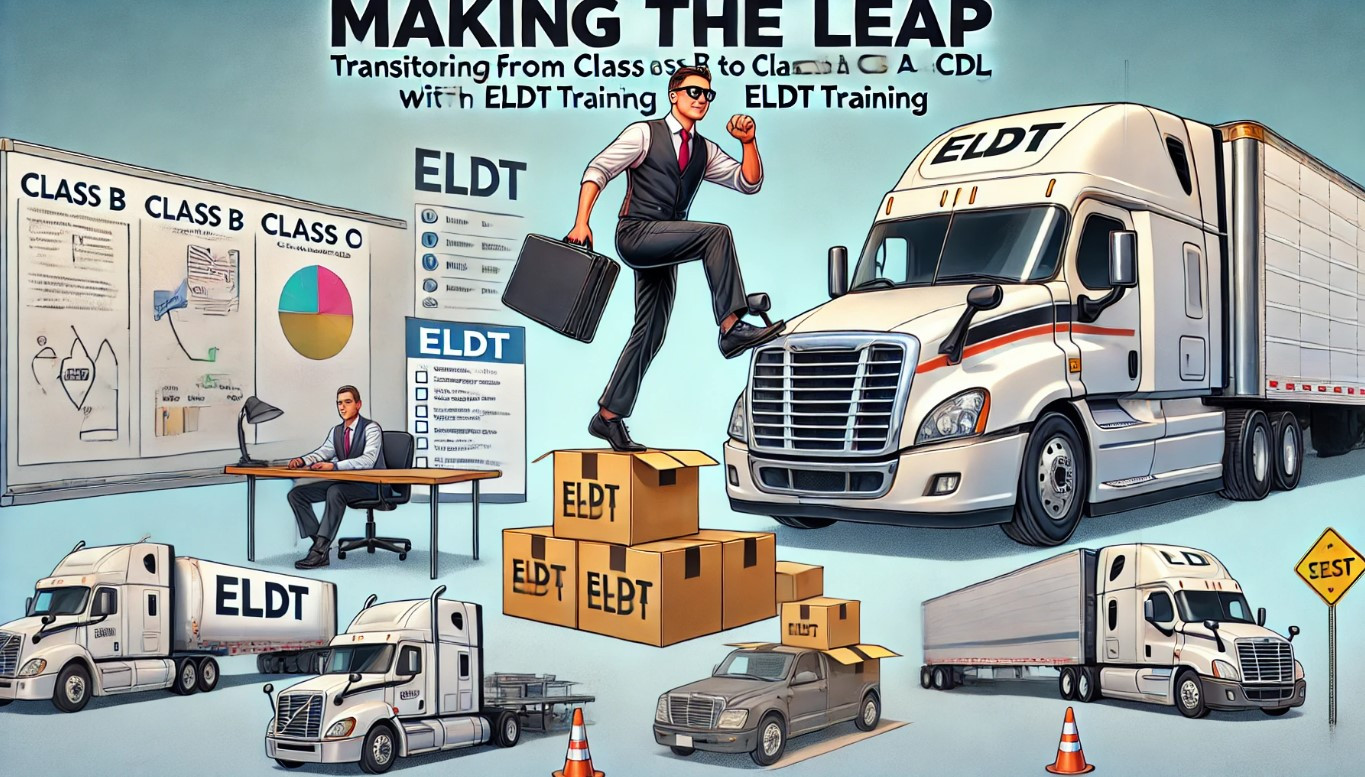The trucking industry is booming, and with it comes increased opportunities for drivers. If you already have a Class B Commercial Driver’s License (CDL) and are considering moving up to a Class A CDL, you’re taking a significant step toward advancing your career. The transition can open doors to higher-paying jobs and allow you to drive larger vehicles with more responsibilities.
At Get Drivers Ed, we specialize in preparing drivers for this crucial leap by offering comprehensive Entry-Level Driver Training (ELDT). This blog will guide you through the transition process, the benefits of upgrading, and how to navigate ELDT requirements.
1. Understanding the Difference Between Class B and Class A CDL
To appreciate the benefits of transitioning, it’s essential to understand the key differences between Class B and Class A CDLs.
Class B CDL:
Allows drivers to operate single vehicles weighing more than 26,001 pounds.
Common vehicles include dump trucks, passenger buses, and delivery trucks.
Class A CDL:
Permits operation of combination vehicles, such as tractor-trailers, with a combined weight of more than 26,001 pounds and a towed vehicle over 10,000 pounds.
Opens opportunities for long-haul trucking and specialized freight transport.
By upgrading to a Class A CDL, you expand your career potential significantly, taking on roles that require driving larger and more versatile vehicles.
2. Benefits of Transitioning to a Class A CDL
Upgrading your CDL isn’t just about driving bigger trucks—it’s about advancing your career and gaining access to new opportunities.
Higher Earning Potential:
Class A CDL drivers typically earn more due to the demand for long-haul and specialized freight transport.
More Job Opportunities:
Access to roles such as interstate trucking, tanker hauling, and heavy freight transport.
Ability to work for larger companies with diverse vehicle fleets.
Enhanced Skill Set:
Gain experience handling larger vehicles and trailers, boosting your expertise and marketability.
Master advanced maneuvers like coupling/uncoupling trailers and navigating tight spaces.
At Get Drivers Ed, we ensure that drivers not only meet regulatory requirements but also develop the skills needed to thrive in their new roles.
3. The Role of ELDT in the Transition Process
The Federal Motor Carrier Safety Administration (FMCSA) requires Entry-Level Driver Training (ELDT) for drivers upgrading their CDL.
What Is ELDT?
ELDT is a standardized training program designed to ensure drivers meet minimum safety and operational standards. It covers both theory and behind-the-wheel training.
ELDT Requirements for Class A CDL Transition:
Theory Training: Covers topics such as vehicle operation, hazard awareness, and regulations.
Behind-the-Wheel Training: Includes range and road training to build hands-on experience.
Get Drivers Ed is an FMCSA-approved training provider, offering ELDT courses tailored to help drivers transition smoothly from Class B to Class A CDL.
4. Steps to Upgrade from Class B to Class A CDL
Upgrading your CDL involves several key steps.
Step 1: Review ELDT Requirements
Understand the ELDT training requirements specific to your upgrade. This ensures you complete the necessary coursework and training hours.
Step 2: Enroll in an Approved ELDT Program
Choose a reputable provider like Get Drivers Ed to complete your theory and behind-the-wheel training.
Step 3: Obtain a Commercial Learner’s Permit (CLP)
Pass the required written exams for Class A CDL.
Hold your CLP for at least 14 days before scheduling the skills test.
Step 4: Schedule and Pass the Skills Test
Demonstrate your ability to safely operate a Class A vehicle, including coupling and uncoupling trailers and navigating various road scenarios.
By following these steps, you’ll be well on your way to obtaining your Class A CDL and unlocking new career opportunities.
5. Tips for Success During the Transition
Transitioning from Class B to Class A CDL can be challenging but manageable with the right preparation.
1. Practice Maneuvering with Trailers:
Spend extra time learning to reverse, couple, and uncouple trailers.
Use training vehicles to familiarize yourself with the larger dimensions.
2. Study the Theory Material Thoroughly:
Review topics covered in the ELDT curriculum, such as safety regulations and pre-trip inspections.
Take practice tests to prepare for the written exam.
3. Leverage Experienced Instructors:
Work closely with instructors to improve your driving skills and address areas of difficulty.
Ask questions and seek feedback to refine your techniques.
At Get Drivers Ed, our experienced trainers are dedicated to helping you succeed through personalized support and comprehensive instruction.
6. Career Opportunities with a Class A CDL
Once you’ve upgraded to a Class A CDL, a wide range of career opportunities becomes available.
Popular Roles for Class A CDL Drivers:
Long-Haul Trucking: Transport goods across states or regions.
Tanker Driving: Haul liquids like fuel or chemicals in specialized vehicles.
Heavy Equipment Transport: Move large machinery and oversized loads.
Job Outlook:
The demand for Class A CDL drivers remains high, with competitive salaries and benefits offered by many companies.
Conclusion: Upgrade Your CDL with Get Drivers Ed
.
Transitioning from a Class B to a Class A CDL is a rewarding step that can significantly advance your driving career. With higher earning potential, more job opportunities, and enhanced skills, the upgrade is well worth the effort.
At Get Drivers Ed, we’re here to guide you through every step of the process, from meeting ELDT requirements to passing the skills test. Our online courses are designed to ensure your success and prepare you for the challenges and opportunities ahead.


